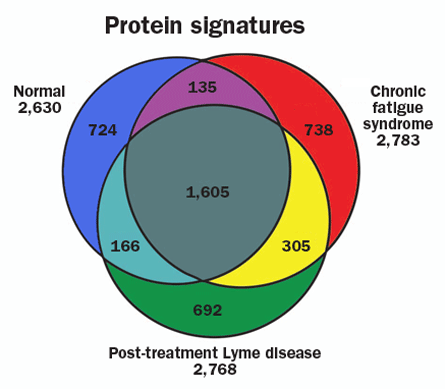Tired, sure, but is it from Lyme disease or chronic fatigue?
A scan of spinal fluid proteins reveals distinct signatures for two conditions
Proteins found in the spinal fluid may serve as biomarkers to help doctors cut through the clutter of symptoms that show up in two groups of patients — those with chronic fatigue syndrome and others with lingering effects from Lyme disease. Different sets of proteins discovered in the two groups indicate these are distinct and distinguishable disorders and that both involve the central nervous system, researchers report in the February PLoS One.

“This provides strong evidence of a biological component” in these conditions, says study coauthor Steven Schutzer, a physician and immunologist at the University of Medicine and Dentistry of New Jersey, in Newark. “There are abnormalities in the spinal fluid, which is really a liquid window on the brain.” But he cautions that the findings represent a first step in seeking biomarkers for the conditions and don’t reveal whether these different protein signatures cause the syndromes or result from them.
Chronic fatigue is a baffling condition marked by prolonged and severe tiredness that isn’t resolved by rest. Its cause is unknown and is often difficult to diagnose and treat. Women are most commonly affected.
Lyme disease results from infection by Borrelia burgdorferi, a bacterium spread by deer ticks. It is treatable with antibiotics, but infections can go unnoticed, delaying treatment. Also, despite clearing the bacterial infection, some patients continue to have longer-term symptoms, including fatigue. Scientists have wondered whether such post-treatment Lyme problems are a form of chronic fatigue, but a connection has never been ascertained.
In the new study, Schutzer and his colleagues analyzed spinal fluid samples from three groups — 11 healthy people, 43 diagnosed with chronic fatigue syndrome and 25 previously treated for Lyme disease but who were still experiencing cognitive problems and fatigue.
Analysis of the fluid samples detected more than 2,600 proteins in each group. Most of the proteins appeared in all three groups. But 692 proteins turned up only in the Lyme patients and 738 others showed up only in the chronic fatigue group.
Some of the condition-specific proteins may ultimately serve as biomarkers, Schutzer says. Identifying 20 or 30 proteins that show up consistently in a condition — but not in healthy people — could form the basis of a diagnostic test for the ailment.
“I think this a great first step,” says Joseph Breen, a biochemist at the National Institute of Allergy and Infectious Diseases in Bethesda, Md. “What’s exciting is that it looks like they’ve been able to tease out differences” between groups of people with these conditions. This finding will need to be validated in more spinal fluid samples from greater numbers of people who have these conditions, he says. A test using blood samples would be even better, since blood is more easily obtained, Breen says.
The new data also provide leads for other researchers to investigate, such as discerning functional roles of proteins that show up in only one condition. This could shed light on the molecular biomechanisms underpinning symptoms seen in patients, Schutzer says.







